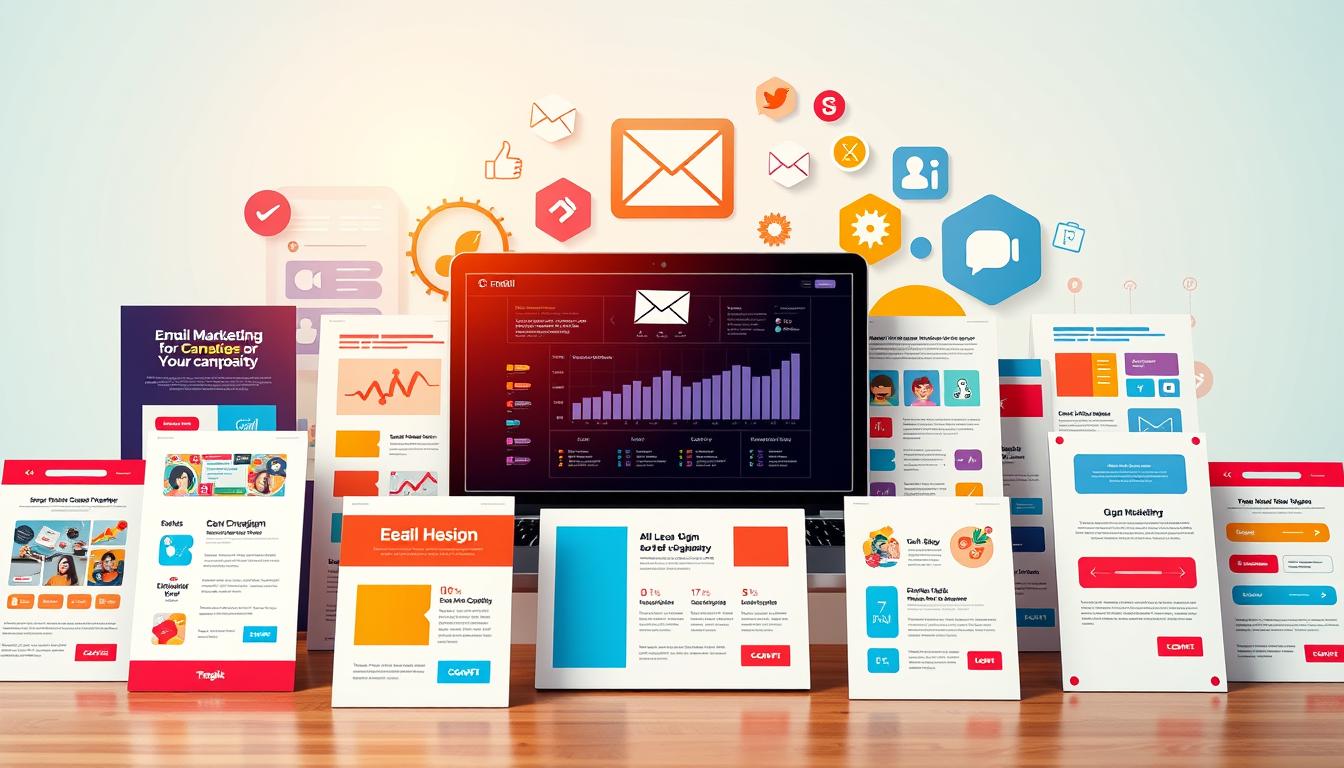Making a great email subject line is hard, but it’s key to get your message seen. Today, with so many emails, it’s tough to stand out.
A good subject line can really help your email get opened more. I’ll share my best tips on effective email subject lines. You’ll learn how to make your email marketing better.
Power of First Impressions: Why Email Subject Lines Matter
First impressions are key, and in email marketing, it’s your subject line that makes the first one. It’s your chance to grab your audience’s attention and make them want to open your email.
The 3-Second Decision Window
You have just 3 seconds to make a good impression. Your subject line is up against many other emails in the inbox. It must be catchy. Studies show that 47% of marketers saw a rise in open rates with personalized subject lines.
How Great Subject Lines Impact Your Bottom Line
A great subject line can really boost your email open rates. This, in turn, can improve your conversion rates and your profits. A study found that emails with personalized subject lines had a 26% higher open rate than those without.
My Personal Subject Line Evolution Story
Over time, I’ve figured out that making the perfect subject line is both an art and a science. Through trying different things, I found that mixing personal touches, creativity, and relevance can really help increase open rates.
| Subject Line Strategy | Open Rate Impact |
|---|---|
| Personalization | +26% |
| Creativity | +15% |
| Relevance | +20% |
By understanding how important your email subject line is, you can use strategies like personalization, creativity, and relevance. This can help you get more people to open your emails and get better results from your email marketing.
Understanding Your Audience: The Foundation of Compelling Subject Lines
Knowing your audience is key to making email subject lines that hit home. You must understand who they are, what they like, and how they see your emails.
Creating Reader Personas for Targeted Messaging
Creating reader personas helps you talk directly to your audience. By making detailed profiles of your perfect subscribers, you can write subject lines that meet their needs. For example, if you sell to both young workers and seniors, your subject lines will be very different.
Adapting Your Tone Across Different Segments
After making your personas, it’s vital to change your tone for each group. What works for one might not work for another. For instance, a formal tone is good for business emails, but a casual tone is better for personal ones.
Tools I Use for Audience Analysis
To really get to know your audience, I use many tools. I use email marketing tools like Mailchimp or Constant Contact to see how people act. Google Analytics also shows me how different groups use my website.
By using these tools and methods, you can really get to know your audience. Then, you can write subject lines that really speak to them.
Psychology Behind High-Converting Subject Lines
To write great subject lines, you need to know what makes people click. It’s about understanding what gets them excited to open emails. This can really boost your email marketing.
Emotional Triggers That Drive Action
Emotions are key in making subject lines stand out. Words that spark excitement, curiosity, or a sense of urgency work well. For example, using action words or hints of something new can grab attention.
Creating FOMO Without Being Manipulative
Fear of Missing Out (FOMO) is a strong motivator. But, you must create urgency without feeling pushy. This means using special offers or time-sensitive info that’s really valuable.
| Technique | Description | Example |
|---|---|---|
| Limited-time Offers | Create urgency with time-bound promotions | “24-Hour Flash Sale: 50% Off!” |
| Exclusive Deals | Make recipients feel special with exclusive content | “Exclusive Access: New Arrivals Inside” |
| Time-sensitive Information | Use timely information to prompt action | “Last Chance: Webinar Registration Ends Today” |
Curiosity Gap Technique
The curiosity gap technique sparks curiosity. It makes people want to know more. You can do this by asking interesting questions or making surprising statements.
Using these techniques can really help your email open rates. It’s all about knowing what your audience wants and giving it to them in a way that feels special.
How to Write Email Subject Lines That Get Noticed
Writing great email subject lines is all about being creative and smart. You need to think about a few important things to grab attention and get people to open your emails.
Finding Your Ideal Character Count
How long your subject line should be is key. Studies say 6-10 words or 50-60 characters work best. This lets you share your message without cutting off on phones. Try different lengths to see what your readers like best.
Power Words That Boost Open Rates
Using strong words in your subject lines can really help. Words like “exclusive,” “limited time,” and “new” make things seem urgent or special. Adding “you” or “your” makes your emails feel more personal and relatable.
Personalization Beyond Just Using Names
Personalizing your subject lines means more than just using names. It’s about making them fit what the person likes or needs. For example, you could mention where they are or something you talked about before. This makes your emails more relevant and likely to be opened.
Mobile Optimization Essentials
Most emails are read on phones, so making your subject lines phone-friendly is essential. Keep them short, avoid spammy words, and put the most important stuff first. This way, you’ll stand out in a crowded inbox.
Clarity vs. Creativity: Finding the Perfect Balance
The art of writing great subject lines is about finding a balance. Email marketers know it’s important to be both clear and creative. A mix of both is the secret to success.
When to Be Direct and When to Be Clever
It’s important to know when to be straightforward and when to be clever. For example, a direct subject line works well for limited-time offers. But for re-engaging inactive subscribers, a creative subject line might be better.
Copywriter tiller said, “The best subject lines are both creative and clear. They grab the reader’s interest and tell the main point of the email.”
Avoiding the Clickbait Trap
Being creative is good, but don’t fall into the clickbait trap. Misleading subject lines might get more opens, but they hurt your credibility. They can also make people unsubscribe more.
Aligning Subject Lines with Email Content
It’s key to make sure your subject line matches your email’s content. Be clear about what the reader will find when they open it. If it doesn’t match, it can disappoint and harm your brand.
By balancing clarity and creativity, and avoiding clickbait, you can make subject lines that open emails and build trust with your audience.
7 Types of Subject Lines That Consistently Perform
In email marketing, a good subject line grabs attention. I’ve tried many types and found seven that work well.
Question-Based Subject Lines with Examples
Using a question in your subject line can grab attention and spark curiosity. For example, “Are You Making These Common Email Marketing Mistakes?” or “What’s the Secret to Boosting Your Productivity?”
Questions make people want to open the email to find out. Here are a few more:
- What’s Holding You Back from Reaching Your Goals?
- Are You Ready to Transform Your Business?
- Do You Know the Hidden Benefits of Our Product?
Benefit-Driven Subject Lines That Convert
Highlighting what your email offers can boost open rates. For example, “Unlock Exclusive Content Just for You” or “Get Instant Access to Our Latest Webinar.”
Benefit-driven subject lines tell readers what they’ll gain. Some examples include:
- Discover How to Save 20% on Your Next Purchase
- Learn the Secrets to Improving Your Email Open Rates
- Boost Your Sales with Our Proven Strategies
Curiosity-Inducing Phrases That Work
Creating curiosity can make people want to open your emails. Phrases like “You Won’t Believe What Happened Next” or “The Surprising Truth About [Topic]” work well.
Here are some more examples of curiosity-inducing subject lines:
- The #1 Thing You’re Doing Wrong in Your Marketing
- The Shocking Reality About [Industry/Topic]
- What the Experts Are Saying About [Trend]
Social Proof Formulations
Using social proof in your subject lines can build trust. For example, “Join the Thousands Who Have Already Benefited” or “See Why Our Customers Love Us.”
Some additional examples include:
- Don’t Just Take Our Word for It – Here’s What Our Customers Say
- Join the Ranks of Successful Businesses Who Use Our Service
- Hear from Our Satisfied Customers
Announcement and News Frameworks
Announcing news or updates can grab attention. Subject lines like “New Arrivals: Exciting Products Inside” or “Important Update Regarding Our Services” work well.
More examples include:
- Breaking News: Introducing Our Latest Feature
- We’re Excited to Announce Our New Partnership
- Stay Informed: Latest Developments in [Industry]
Urgency and Scarcity Approaches
Creating a sense of urgency or scarcity can prompt action. Examples include “Limited Time Offer: Don’t Miss Out” or “Only a Few Hours Left to Grab This Deal.”
Some more examples are:
- Last Chance to Register for Our Webinar
- Hurry! Sale Ends Soon
- Don’t Miss Out: Limited Stock Available
Problem-Solving Subject Line Templates
Addressing a problem or solution can be effective. For instance, “Tired of [Problem]? Here’s a Solution” or “Solve Your [Problem] with Our Expert Tips.”
Here are some templates you can use:
| Problem | Solution |
|---|---|
| Struggling with low email open rates? | Boost Your Open Rates with Our Proven Strategies |
| Having trouble with customer engagement? | Discover How to Engage Your Customers Effectively |
| Looking for ways to increase sales? | Learn the Secrets to Boosting Your Sales |
As Marketing Expert once said, “The key to successful email marketing lies in understanding your audience and crafting messages that resonate with them.” By using these seven types of subject lines, you can significantly improve your email marketing performance.

A/B Testing: My Data-Driven Approach to Optimization
A/B testing changed how I write email subject lines. I test different versions to see what works best. This helps me make my emails more effective.
Setting Up Meaningful Subject Line Tests
I start A/B tests with a clear idea. For example, I might check if personal emails get more opens. I use email marketing tools like Mailchimp or HubSpot for these tests.
Variables Worth Testing
It’s important to test things like how long the subject line is, if emojis help, and if personal touches matter. Here’s what each can do:
| Variable | Potential Impact |
|---|---|
| Subject Line Length | Shorter lines work better on phones. |
| Use of Emojis | Emojis make emails more fun to open. |
| Personalization | Using names can get more people to read. |
Interpreting Results and Implementing Changes
After the test, I look at the numbers to see what worked. If one version is clear winner, I use it for all future emails.
Tools That Make Testing Easy
I use tools like Mailchimp, HubSpot, and VWO for A/B testing. They show me what works and what doesn’t. This helps me get better at writing subject lines.
With A/B testing, I keep making my email subject lines better. This helps my campaigns do well.
Subject Line Mistakes That Tank Your Open Rates
Just a few mistakes in your email subject lines can hurt your open rates a lot. I’ve seen many marketers, including myself, make these errors. They forget about important details.
Spam Trigger Words and Phrases to Avoid
Some words and phrases can make your email go to spam. Here’s a list of common ones to avoid.
- Using too much punctuation like !!!
- Words like “Free” or “Discount”
- “Limited time offer” to create urgency
Punctuation and Formatting Errors
Wrong punctuation and formatting can make your subject line look bad. Too many capital letters or missing punctuation can scare people off.
Overpromising and Credibility Killers
Being too optimistic in your subject lines can make people distrust you. If your email doesn’t live up to the subject line, your trustworthiness drops.
Timing Missteps That Hurt Performance
Sending emails at the wrong time can really hurt your open rates. Knowing when your audience is most active is key.

| Mistake | Impact | Solution |
|---|---|---|
| Spam Triggers | Emails go to spam | Avoid trigger words |
| Punctuation Errors | Looks unprofessional | Proofread carefully |
| Overpromising | Damages credibility | Be honest and clear |
| Timing Missteps | Low open rates | Test and optimize timing |
By avoiding these common mistakes, you can boost your email open rates. This will also improve your campaign’s overall success.
Industry-Specific Subject Line Strategies
Good email marketing starts with the right subject lines. Each industry has its own way of seeing these lines.
B2B vs. B2C Approaches That I’ve Tested
B2B and B2C emails need different subject lines. B2B emails should be professional and talk about value and trends. Using recent reports or trends can help a lot.
B2C emails do better with casual, personal lines. They should make you feel something or hurry you up. For example, special deals or limited-time offers work well.
| Industry | Effective Subject Line Strategies | Example |
|---|---|---|
| B2B | Professional tone, industry insights | “Unlock the Latest Trends in Digital Marketing” |
| B2C | Casual tone, personalized, emotional triggers | “Exclusive Sale: 24-Hour Flash Deal!” |
Retail and E-commerce Subject Line Tactics
Retail and e-commerce emails do well with urgency. Lines like “Last Chance” or “Limited Stock” push people to buy.
Personal touches are also key. Using names or past purchases makes emails feel more personal.
Service-Based Business Strategies
Service businesses like consulting or healthcare need trusty subject lines. Show off your skills and success stories to build trust.
Seasonal and Timely Optimization Tips
Timing is everything in email marketing. Use seasonal events or timely offers to grab attention. For example, Black Friday or Cyber Monday can be big.
Know your industry well and adjust your subject lines. This will help your emails get more attention and action.
Conclusion: Turning Subject Line Mastery Into Lasting Results
Learning to write great email subject lines is very important. It helps you get more people to open your emails. This can lead to more sales and happy customers.
This article has given you many tips to make your emails better. You can try different things to see what works best. This way, you can make your emails more interesting and effective.
Keep working on making your subject lines better. It’s important to be consistent and creative. Always look for new ideas and test them to get the best results.
FAQ
What makes an email subject line effective?
A good email subject line grabs your attention. It should match the email’s content. Using personal touches, strong words, and emotions can help a lot.
How long should my email subject line be?
Keep your subject line short, under 50 characters. This makes sure it shows up right on mobiles.
Can I use spam trigger words in my subject lines?
No, avoid words like “Free” or “Limited time offer.” They might mark your email as spam. Always check your subject lines against spam lists.
How do I know what type of subject line works best for my audience?
Try different subject lines with A/B testing. Use questions, benefits, and curiosity to see what gets more opens.
Should I use personalization in my subject lines?
Yes, personal touches work well. Use names or interests to grab more attention.
How often should I change my subject line strategy?
Change your strategy often. Use data and stay updated with trends to keep your subject lines effective.
Are there any industry-specific subject line strategies I should be aware of?
Yes, different industries need different approaches. Tailor your subject lines to fit your industry and audience.
Can I use A/B testing tools to optimize my subject lines?
Yes, A/B testing tools are great. They help find the best subject line variations. Use tools like Mailchimp or HubSpot for easy testing.
What are some common subject line mistakes to avoid?
Avoid spam words, errors, overpromises, and bad timing. Always proofread and test your subject lines.









Leave a comment